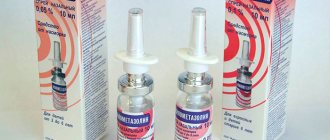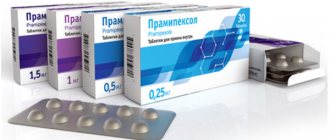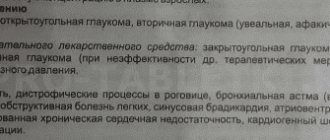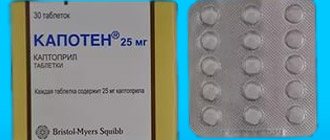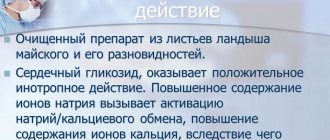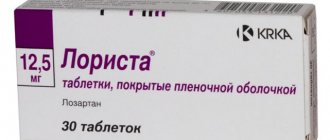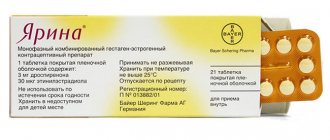Release form and composition
The drug is available in the form of 0.05% and 0.1% nasal drops, 0.05% and 0.1% eucalyptus nasal spray.
The drops are a clear, colorless or yellowish solution, 1 ml of which contains:
- 500 mcg or 1 mg xylometazoline hydrochloride;
- Such auxiliary components as: sodium hydrogen phosphate, disodium edetate, sodium chloride, potassium dihydrogen phosphate, benzalkonium chloride, purified water.
Drops are sold in polymer bottles of 10, 15 and 25 ml with and without a dispenser.
The spray is a colorless or slightly colored liquid with a characteristic eucalyptus odor, 1 ml of which contains:
- 500 mcg or 1 mg xylometazoline hydrochloride;
- Such auxiliary components as: sodium hydrogen phosphate dodecahydrate, disodium edetate dihydrate, benzalkonium chloride, potassium dihydrogen phosphate, sorbitol, macrogol glyceryl hydroxystearate, sodium chloride, glycerol, eucalyptus oil, purified water.
The spray is sold in bottles with a spray nozzle of 10 and 20 ml.
Indications for use of Xylometazoline
As stated in the instructions for Xylometazoline, this decongestant is intended for short-term symptomatic treatment:
- Acute allergic rhinitis;
- Sinusitis;
- acute respiratory infections with symptoms of rhinitis;
- Hay fever;
- Otitis media (as an adjuvant to relieve swelling of the nasal mucosa).
In addition, Xylometazoline, according to the instructions, is prescribed to patients in preparation for diagnostic manipulations and procedures in the nasal passages.
Contraindications
According to the annotation for this medication, the use of Xylometazoline is contraindicated:
- Patients with glaucoma;
- With severe atherosclerosis;
- For angle-closure glaucoma;
- With tachycardia;
- With atrophic rhinitis;
- With thyrotoxicosis;
- Patients who have undergone surgery on the meninges;
- Children under 6 years old in the form of a 0.1% solution;
- If you have hypersensitivity to xylometazoline hydrochloride or any auxiliary component.
Xylometazoline is prescribed, but according to strict indications and under the constant supervision of a doctor:
- Pregnant women;
- For angina pectoris;
- Patients with prostatic hyperplasia;
- Children under 2 years old in the form of a 0.05% solution;
- During lactation;
- Patients with diabetes mellitus.
Xylometazoline overdose symptoms
— 1 ml contains: xylometazoline hydrochloride 500 mcg.
Excipients: benzalkonium chloride 150 mcg/ml, disodium edetate dihydrate 500 mcg/ml, potassium dihydrogen phosphate 3.63 mg/ml, sodium hydrogen phosphate dodecahydrate 7.13 mg/ml, sodium chloride 7 mg/ml, eucalyptus oil 500 mcg/ml, sorbitol 8 mg /ml, glycerol 4 mg/ml, macrogol glyceryl hydroxystearate 3.4 mg/ml, purified water to 1 ml.
https://www..com/watch?v=ytdeven-GB
— 1 ml contains: xylometazoline hydrochloride 1 mg.
In 1 ml drops of 0.05% and 0.1% xylometazoline 500 mcg and 1 mg, respectively. Sodium hydrogen phosphate, potassium dihydrogen phosphate, sodium chloride, benzalkonium chloride as auxiliary components.
In 1 ml of spray there are 0.05% and 0.1% xylometazoline 500 mcg and 1 mg, respectively. Sodium hydrogen phosphate, benzalkonium chloride, disodium edetate dihydrate, potassium dihydrogen phosphate, eucalyptus oil, sodium chloride, macrogol glyceryl hydroxystearate, sorbitol, glycerin, water as auxiliary components.
1 g of xylometazoline gel contains 1 mg. Carbomer, glycerol, ammonia solution, propylene glycol ethanol, methylparaben, propylparaben, water as auxiliary components.
Pharmacodynamics and pharmacokinetics
Pharmacodynamics
Xylometazoline is an imidazoline derivative. Stimulates α1 and 2-adrenergic receptors of the blood vessels of the nasopharyngeal mucosa. As a result, blood vessels narrow, hyperemia, swelling of the mucous membrane and nasal discharge decrease. As a result, it is easier to breathe through the nose during rhinitis, allergic conditions and diseases of the paranasal sinuses.
Pharmacokinetics
The pharmacokinetics of the drug have not been studied in humans. Sometimes, when applied topically, absorption is sufficient to produce systemic effects.
When applied topically, xylometazoline is practically not absorbed, so its concentrations in blood plasma are very low (not determined by modern analytical methods).
Indications for use
- rhinitis of various etiologies (allergic, viral, traumatic, bacterial);
- rhinopharyngitis;
- otitis media and eustachitis;
- to facilitate the discharge of secretions during sinusitis;
- to facilitate diagnostic manipulations in the nasal passages.
Use with caution during pregnancy. In pediatrics, the drug with a concentration of 0.1% is not used.
Indications for use of the spray
https://www..com/watch?v=ytcreatorsen-GB
are: acute respiratory diseases with symptoms of rhinitis (runny nose); acute allergic rhinitis, sinusitis, hay fever; otitis media (as part of combination therapy to reduce swelling of the nasopharyngeal mucosa); preparing the patient for diagnostic procedures (rhinoscopy).
Contraindications to the use of the drug
are: hypersensitivity to the components of the drug, arterial hypertension, tachycardia, severe atherosclerosis, glaucoma, atrophic rhinitis, thyrotoxicosis, surgical interventions on the meninges (history), children under 2 years of age for using a 0.05% solution and up to 6 years - for 0.1% solution.
Do not use during therapy with monoamine oxidase inhibitors (MAO) and tricyclic antidepressants.
Carefully. IHD (angina pectoris III-IV functional class), prostatic hyperplasia, diabetes mellitus, pregnancy, lactation.
Side effects
With frequent and/or long-term use of the spray
https://www..com/watch?v=ytcopyrighten-GB
- irritation and/or dryness of the nasopharyngeal mucosa, burning, paresthesia, sneezing, hypersecretion; swelling of the nasal mucosa, palpitations, tachycardia, arrhythmia, increased blood pressure, vomiting, headache, insomnia, blurred vision; depression (with long-term use of high doses).
- burning in the nose and throat;
- mucosal irritation;
- dryness of the nasopharynx;
- sneezing;
- headache;
- dizziness;
- swelling of the nasal mucosa;
- insomnia;
- heart rhythm disturbance;
- tachycardia;
- increased blood pressure;
- increased excitability;
- visual impairment;
- vomit;
- depression.
Spray
should be used with caution during pregnancy and lactation.
Xylometazoline can be used to reduce nasal discharge during pregnancy. Experience with the use of this drug in pregnant women is limited, but short-term use in minimal doses is allowed under strict medical supervision. Oxymetazoline, despite the fact that it is also an imidazoline derivative, is contraindicated during pregnancy.
Additionally
Use in children. Contraindication: children under 2 years of age for using a 0.05% solution and under 6 years of age for a 0.1% solution.
Before use, it is necessary to clean the nasal passages. Should not be used for more than 7 days.
Typically, xylometazoline does not affect performance and does not make it difficult for vehicle drivers to work or control moving machinery.
In some cases, frequent and/or long-term use of the drug may lead to adverse reactions that impair the ability to drive a car or operate machinery.
For acute rhinitis in children, it is not advisable to use short-acting vasoconstrictors: Naphazoline, Tetrizoline, Ephedrine, since after their use there is recurrent swelling of the nasal mucosa. It is preferable to use long-acting drugs: Xylometazoline (Dlyanos, Otrivin), Oxymetazoline (Nazivin), Epinephrine (Vibrocil), which allows you to reduce the frequency of use.
Remember that the risk group for poisoning with imidazoline (Xylometazoline) drugs are children under 2 years of age. This drug is not recommended for use in newborns, infants, or children under 2 years of age. In rare cases, if there is no alternative, 0.05% drops are prescribed to children under 2 years of age.
For children over 2 years of age, only a 0.05% concentration of this drug is used, and it is necessary to strictly dose and observe the frequency of use.
From 2 to 6 years, 0.05% drops, 1 to 2 drops at each turn, twice a day, if necessary, use up to 3 times a day is acceptable. From 6 to 12 years, you can use 0.05% drops and 0.05% spray 2-3 drops or one injection per stroke, but no more than 3 times a day.
Children over 7 years old are prescribed 0.05% gel - placed 3-4 times a day deep into each stroke.
From 12 years old, 0.1% drops and spray are used.
It is necessary to take into account that frequent and long-term (more than 5 days, in some authors - more than 3 days) use of this drug can cause a pronounced decrease in local blood flow, as a result of which inadequate blood supply to the mucosa develops, up to its atrophy in the future. In this regard, you should not use the drug in any form of release more than 3 times a day or for more than 3-5 days.
If there is a need to use nasal drops at an earlier age, then Vibrocil is approved for use in children from infancy. In infants, Nazivin 0.01% is also used, from the age of 1 year - Nazivin 0.025%. Ximelin Eco Ximelin Nazivin Galazolin Lazorin Nazivin Sensitive for children Otrivin Naphthyzin Sanorin Noxprey Dlynos Lazolvan Rino Afrin Rhinorus Evkazolin Aqua Rinazolin Grippostad Rino Farmazolin Nazol Advance Nazol Baby
Analogues: Farmazolin, Farmazolin N, Galazolin, Xylo-mefa, Meralis, Otrivin, Otrivins with menthol and eucalyptus, Tizin Xylo.
Differences between Xylometazoline and Oxymetazoline
Xylometazoline and Oxymetazoline belong to the group of imidazolines, acting on α1 and 2 adrenergic receptors and have a longer effect than drugs of the phenylephrine group: 10 hours of action.
For long-acting drugs, the effect does not occur immediately, but after 10–15 minutes. The long-term vasoconstrictive effect allows them to be used 1-2 times a day, provides restful sleep, but causes a greater risk of damage to the mucous membrane, including atrophy. However, if you do not exceed the period of continuous use (3-4 days), the risk is reduced.
The difference between Xylometazoline and Oxymetazoline is only in the duration of action. Xylometazoline is a drug with an average duration of action of 8-10 hours. Known preparations of xylometazoline: Xylen, Rinostop, Galazolin, Xymelin, Otrivin, Farmazolin, Dlyanos, Tizin-Xylo. Oxymetazoline is a long-acting drug - up to 12 hours.
Reviews
https://www..com/watch?v=cosamomglavnom
Reviews about the use of the drug are mostly positive, everyone notes the effectiveness and duration of action, which is very convenient during the working day and throughout the night.
https://www..com/watch?v=upload
The drug in drops is difficult to dose, since part of the solution enters the pharynx, so side effects occur more often. In this regard, it is safer to use a metered spray. Many people note undesirable reactions: insomnia, neurosis, anxiety.
Another unpleasant phenomenon that is often written about in reviews is rebound congestion, the so-called “medicinal rhinitis.” Long-term use of the drug leads to the fact that vasoconstriction is replaced by increased blood flow and the resumption of secretions. Nasal congestion returns and cannot be treated with medication.
Source: https://onsmeta.ru/peredozirovka-ksilometazolinom-simptomy/
Directions for use and dosage of Xylometazoline
Nasal drops in a concentration of 0.1% are prescribed to children from 6 years of age and adults 2-3 drops. in each nasal passage three times a day. Children under 6 years of age can only use a 0.05% solution. It is prescribed 1-2 drops in each nasal passage twice a day.
Nasal spray at a concentration of 0.1% is prescribed to adults and children over 6 years of age, one injection into each nasal passage 2-3 times a day. Children 2-6 years old - 0.05% spray, one injection 1-2 times a day.
Like any vasoconstrictor, Xylometazoline is not recommended for use for more than 7 days in a row, because it can be addictive. If no improvement is observed during this time, you should consult a doctor to clarify the diagnosis and prescribe appropriate treatment.
Xylometazoline nasal drops: instructions for use and reviews
Xylometazoline-SOLOpharm drops are prescribed in otorhinolaryngology to relieve nasal congestion and ease breathing. The therapeutic effect is observed due to the vasoconstrictor effect of the main chemical substance of the drug. The active ingredient is the name of the drug, the amount of which varies depending on the percentage of drops produced.
Composition and release form
Xylometazoline nasal drops have the form of a colorless, transparent solution, a slight light yellow color is allowed. The active ingredient is xylometazoline hydrochloride. Additional chemicals that affect the absorption of the active substance, preserve the shelf life, and ensure the liquid state of the drug:
- benzalkonium chloride;
- purified water;
- sodium chloride;
- sodium dihydrogen phosphate dihydrate;
- sodium hydrogen phosphate dodecahydrate.
The solution is poured into glass bottles equipped with a dropper cap. Volume – 10 ml. The nasal drug is available in the form of a spray of 0.05%, 0.1% and gel 0.1%.
Pharmacodynamics, pharmacokinetics
The active substance is an imidazole derivative, the structure of the molecules is similar to naphazoline. The active component stimulates alpha1 and alpha2 adrenergic receptors in the walls of blood vessels in the nasopharynx area. By reducing the diameter of the vessels, tissue swelling and redness are reduced, and the amount of mucous discharge from the nasal cavity is reduced.
When instilled into the nose, xylometazoline hydrochloride practically does not enter the general bloodstream; it acts only locally - on the nasal mucosa. Its concentration in the liquid part of the blood is so low that it is sometimes impossible to determine even with the help of modern laboratory tests.
Indications for use of Xylometazoline drops
The product is used to get rid of nasal congestion with:
- acute allergic rhinitis;
- sinusitis;
- rhinopharyngitis;
- viral, bacterial rhinitis;
- hay fever;
- otitis media to reduce swelling of the nasopharyngeal tissues.
Otolaryngologists prescribe the drug to prepare patients for diagnostic procedures in the nasal cavity.
Read more How to use Proproten 100 drops: instructions and reviews
Restrictions on the use of Xylometazoline drops
The vasoconstrictor solution must not be used when:
- angle-closure glaucoma;
- high blood pressure;
- tachycardia;
- angina pectoris;
- prostatic hyperplasia;
- atrophic rhinitis;
- hypersensitivity to chemicals in the solution;
- pronounced atherosclerotic damage to the vascular walls;
- hyperfunction of the thyroid gland.
The drug is prohibited for people who have undergone surgical treatment on the membranes of the brain. Use with caution in children under 2 years of age, pregnant women, and nursing mothers.
Instructions for use, dosage of Xylometazoline drops
Before use, it is necessary to clear the nasal passages of crusts and mucous discharge. You can rinse your nose with saline solution or special means, for example, Aqualor.
Before instillation, it is recommended to hold the bottle in your hands so that the solution warms up. The head is tilted slightly back and the required number of drops is added.
If the procedure was missed, the next time the product is dripped in the same amount; the missed drop is not added.
Adults are advised to take 1-2 drops in each nasal passage 3 times a day. Only 0.05% drops are allowed for babies; 0.1% is not used in pediatrics.
The number of drops and frequency are determined by the doctor, the standard dosage is 1 drop 2 times a day. Duration of use is no more than 5 days, regardless of age.
Considering that the active substance may enter the general bloodstream, it is not recommended to exceed the amount of the drug or increase the multiplicity.
Use of the drug in children
In acute rhinitis, it is not recommended to use short-acting intranasal vasoconstrictor drugs, such as Ephedrine, Naphazoline, since after their use, swelling of the nasal mucosa often returns. Preference is given to products containing xylometazoline hydrochloride as the active substance: Dlyanos, Otrivin or containing oxymetazoline: Vibrocil, Nazivin.
Children under 2 years of age are more likely to be at risk of xylometazoline poisoning. According to the instructions, it is not recommended for use in newborns and children under two years of age. If prescribing the drug is necessary, use only a 0.05% solution; for older children, the concentration of drops is also 0.05%.
Side effects
If used too frequently, if there is hypersensitivity to the components of the product or for other reasons, side effects may occur:
- burning, irritation of the nasal mucosa;
- sneezing;
- swelling of the nasal membrane;
- headache;
- dizziness;
- tachycardia;
- increased blood pressure;
- decreased visual acuity;
- nausea;
- sleep disturbance;
- heart rhythm disturbance.
Overdose
If you use the drug beyond the specified period in the instructions, systematically exceed the permissible number of drops per day, an overdose may result in side effects of varying severity. If you accidentally drink, an overdose may occur:
- dilated pupils;
- bluish coloration of the skin;
- nausea;
- vomiting;
- fever;
- disturbances in heart rhythm and breathing;
- rise in blood pressure;
- mental disorders;
- pulmonary edema.
Read more The benefits and harms of Taurine eye drops
The appearance of drowsiness, bradycardia, respiratory failure, fainting, coma indicates inhibition of the function of the central nervous system under the influence of the active substance Xylometazoline drops.
After taking the medicine orally, call an ambulance. Before her arrival, induce vomiting and take a sorbent (activated carbon, Polysorb or others). Treatment in a hospital: gastric lavage, symptomatic treatment, in case of coma - hospitalization in the intensive care unit.
Additional Information
When instilling the solution for more than 5 days, more than 3 times a day, the blood supply to the vessels of the nasal cavity may be impaired. Xylometazoline narrows the walls of blood vessels, accordingly, blood flow decreases, which can manifest itself as a violation of tissue nutrition, including atrophic changes in the nasal mucosa.
Interactions with drugs
The effect of the active substance of the drops is enhanced by drugs that have a stimulating effect on the sympathetic nervous system. Xylometazoline should not be combined with MAO inhibitors or antidepressants, as their combined use can lead to a hypertensive crisis.
Expiration date, storage conditions, sale
You can buy Xylometazoline drops without a doctor's prescription. Store the drug away from children and direct sunlight at a temperature of about 25°C. The shelf life of the medicinal properties is 3 years from the date of manufacture of the solution indicated on the package.
The average cost of Xylometazoline drops in Russia is 40 rubles.
Analogs
If necessary, Xylometazoline nasal drops can be replaced with similar drugs. Analogs of drops in composition and chemical structure:
Analogs of Xylometazoline drops according to indications for use:
When replacing a drug based on xylometazoline with products whose active ingredient is naphazoline, one must take into account that they cause physical and psychological addiction.
With prolonged instillation, the regulation of the tone of the vascular walls is disrupted, which can lead to drug-induced rhinitis.
Therefore, when selecting an analogue, it is better to choose nasal drops whose active ingredient is xylometazoline.
Read more Instructions for using nasal drops for children Nazol Baby
Reviews
Stanislav, 29 years old, Moscow Used drops for a severe runny nose. I didn’t go to the doctor, I bought it on the recommendation of a pharmacist. I took 1 drop 3 times a day, sometimes 2. The congestion went away within 5 minutes, but it didn’t last long. After 2-4 hours, my nose was not breathing again, but I didn’t buy any other drops, the runny nose went away on its own.
In general, I am dissatisfied with the product. Marina, 34 years old, Perm I have been buying Xylometazoline for several years now. The first time I used it for sinusitis on the recommendation of an ENT doctor, the drug helped a lot. Now I buy it for nasal congestion due to colds. I like the drug not only for its fast action, but also for its affordable price; I buy it for 45 rubles.
Ksenia, 31 years old, Vladikavkaz Xylometazoline 0.05% was prescribed to my son when he had sinusitis. I read the list of side effects, and the desire to give the drug to the baby disappeared. I asked the pediatrician to replace the product with another one intended specifically for children.
The doctor said that side effects occur when the dosage or frequency of use is not observed, but still prescribed another drug - Nazivin
Xylometazoline drops have a pronounced vasoconstrictor effect, and therefore their long-term use is prohibited so as not to cause disruption of the nutrition of the nasal mucosa.
Most reviews about the drug are positive; negative reviews are more often associated with a dosage violation or an allergic reaction to the components in the composition.
Source: https://infofarma.ru/kapli/ksilometazolin
Side effects of Xylometazoline
Numerous reviews from patients who were treated with Xylometazoline indicate that this drug is well tolerated and does not have side effects if the dosage regimen recommended by the doctor is followed.
However, it should be noted that in individual cases the following are possible: increased blood pressure, disturbances in heart rhythm, vision, sleep disturbance, headache, vomiting.
With prolonged and/or frequent use of Xylometazoline, burning, hypersecretion, irritation, tingling and dryness of the nasal mucosa, as well as a depressive state, are possible. It is also worth noting that the latter phenomenon occurs in extremely rare cases if the patient uses the drug in high doses for a long period.
An overdose of a drug is fraught with the appearance of side effects or intensification of existing ones.
If the drug is accidentally taken orally (more often in children), the following may occur: arrhythmia, tachycardia, confusion, increased blood pressure, decreased body temperature, shock-like hypotension, bradycardia, drowsiness, apnea and coma. Therefore, in this case, you should immediately call an ambulance.
special instructions
For a long period, for example, with chronic rhinitis, the use of any vasoconstrictor is not recommended, as there is a risk of developing addiction to the medication, reducing the sensitivity of blood vessels to the active substance, or secondary vasodilation, which provokes swelling of the nasal mucosa.
Before using Xylometazoline, you should clear the nasal passages of crusts and mucus, this will allow the drug to act on the mucous membrane, thereby improving the therapeutic effect.
Xylometazoline hydrochloride is pharmaceutically incompatible with tricyclic antidepressants and MAO inhibitors. And when used together with non-selective monoamine reuptake inhibitors, hypertension may develop.
Xylometazoline* | Instructions for use of drugs, analogues, reviews
PRESCRIPTION MEDICINES ARE PRESCRIBED TO THE PATIENT ONLY BY A DOCTOR. THIS INSTRUCTION IS FOR MEDICAL PROFESSIONALS ONLY.
Naumov Yu.N. Mon, 29/10/2012 – 14:54
Formula: C16H24N2, chemical name: 2-[[4-(1,1-Dimethylethyl)-2,6-dimethylphenyl]methyl]-4,5-dihydro-1H-imidazole (as hydrochloride). Pharmacological group: Vegetotropic drugs/adrenomimetic drugs/alpha-adrenomimetics; anticongestants. Pharmacological action: anticongestive, vasoconstrictor.
Pharmacological properties
Xylometazoline has a stimulating effect on alpha-adrenergic receptors. When used topically, it is practically not absorbed, so the content of the drug in plasma is very small (not determined analytically).
Application of xylometazoline to the mucous membranes leads to vasoconstriction, reducing swelling and local hyperemia. Xylometazoline for rhinitis improves nasal breathing.
The effects of xylometazoline develop within a few minutes and last for several hours.
Indications
Allergic and acute infectious and rhinitis; hay fever; otitis media (to relieve swelling of the mucous membrane in the nasopharynx as part of a combination treatment); sinusitis; to prepare the patient for diagnostic procedures and manipulations in the nasal cavity.
Method of administration of xylometazoline and dose
Xylometazoline is used intranasally.
Patients over 6 years of age: 4 times a day (usually) one injection into each nostril from a nebulizer or 2-3 drops of a 0.1% solution into each nostril; patients under 6 years of age: no more than 3 times (usually 1 or 2) a day in each nostril of a 0.05% solution, 1-2 drops; nasal gel (only for patients over 7 years old): 4 times a day (use 4 times shortly before bedtime) place a small amount of gel as deep as possible into both nostrils. Duration of therapy is 3–5 days (no more). If you miss the next use of xylometazoline, do it as you remember, next time use after the set time from the last use.
Before using the drug, you need to clean your nasal passages. Do not use for a long time (for example, during chronic rhinitis). For colds, when crusts may form in the nose, it is preferable to use xylometazoline in gel form.
Contraindications for use
Hypersensitivity, children's age (for gel up to 7 years, for 0.1% solution up to 6 years, for 0.05% solution up to 2 years), tachycardia, severe atherosclerosis, hypertension, history of surgical interventions on the meninges, glaucoma, hyperthyroidism, atrophic rhinitis.
Restrictions on use
Coronary heart disease, prostate hyperplasia, diabetes mellitus.
Use during pregnancy and breastfeeding
During breastfeeding and pregnancy, xylometazoline should be used only after a careful assessment of the balance of benefit to the mother and the possible risk to the child or fetus; Do not exceed recommended doses.
Side effects of xylometazoline
With prolonged and frequent use - irritation of the mucous membrane, tingling, burning, sneezing, hypersecretion, dryness, swelling of the nasal mucosa; rarely - palpitations, hypertension, arrhythmias, headache, sleep disturbance, vomiting, blurred vision, anxiety, depression (with prolonged use in high doses).
Interaction of xylometazoline with other substances
Xylometazoline is incompatible with monoamine oxidase inhibitors and tricyclic antidepressants.
Trade names of drugs containing the active ingredient xylometazoline
| Brizolin®Galazolin® Grippostad® RhinoDlyanos®Doctor Theiss NazolinDoctor Theiss Rhinotheiss Asterisk NOZInflurinXylene®XylobeneXylometazoline | Xylometazoline bufusXylometazoline, nasal dropsXylometazoline-BetalekXylometazoline-RusfarXylometazoline hydrochlorideXymelin®Xymelin® EcoXymelin® Eco with mentholNosolin®Nosolin®-balmOlint | Otrivin®RinonormRinorus®RinostopSialorSnoop®Suprima-NOZTizin XyloTizin® Xylo BIOPharmazolin®EVCAZOLIN AQUA |
- Vegetotropic agents
- Adrenergic agonists
Source: https://listel.ru/%D0%BA%D1%81%D0%B8%D0%BB%D0%BE%D0%BC%D0%B5%D1%82%D0%B0%D0%B7 %D0%BE%D0%BB%D0%B8%D0%BD
